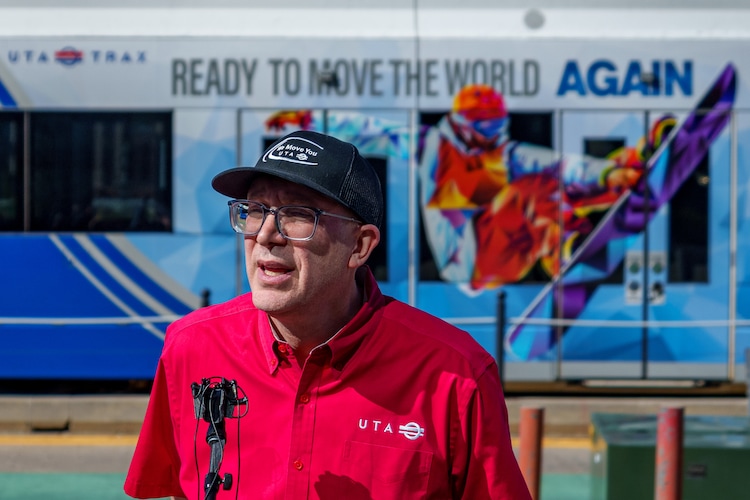Train bells rang and traffic rumbled by as U.S. Olympic and Paralympic leaders met with Utah Transit Authority officials in Salt Lake City this week to discuss significant transit upgrades planned for the potential 2034 Olympics host city.
Four years before the international spectacle, there should be a new “orange” light-rail line running between Salt Lake City International Airport and the University of Utah.
The TRAX blue line should also be redesigned by 2030, running from the airport down to Draper, executive director Jay Fox said Wednesday outside of the Delta Center TRAX stop.
And strategic double-tracking is planned for the FrontRunner, allowing for the commuter train to operate every 15 minutes by the same year, stretching 80 miles from Brigham City down to Payson. The railroad currently stretches from Ogden to Provo and runs 30-minute service on weekdays.
“The biggest thing that I’m looking forward to, in addition to the expansions that I was talking about, is just that increased frequency,” Fox said.

(Trent Nelson | The Salt Lake Tribune) Jay Fox, Utah Transit Authority executive director, speaks to media as an Olympic-wrapped UTA TRAX light rail train arrives at the Arena Station next to the Delta Center in Salt Lake City on Wednesday, April 10, 2024.
The plans also call for a new rapid-transit bus line, stretching from Farmington to the University of Utah. And UTA plans to implement higher-frequency bus routes, called “go routes,” that would work hand-in-hand with the city’s master transit plan, Fox said.
He pointed to the city hosting the NBA All-Star Game last year — essentially a mini-test for UTA, helping the agency find ways it can work more efficiently.
“Customer experience is everything,” Fox said.
What’s to come stands to benefit “generations” of Utahns, Fox said. But UTA does face challenges on the road to 2030, including work to restore routes that have been reduced in frequency — or cut altogether — in the next two years.
The major factor is labor. Fox said UTA is currently is working on a “sustainable service delivery system” that would give employees a more predictable work schedule as the agency prioritizes better retaining existing employees.
“We’ve been able to bring people in,” Fox said of UTA’s hiring efforts. “It’s just making sure that we can keep them by giving them a lifestyle, particularly post-pandemic, that works for them — at the same time we’re able to operate our system.”
(Utah Transit Authority) A map of UTA's planned improvements for public transit across the Wasatch Front.
Editor’s note • This story is available to Salt Lake Tribune subscribers only. Thank you for supporting local journalism.








